Responsive Web Design Report: Mobile Web Design & User Experience
VerifiedAdded on 2023/06/04
|6
|1387
|494
Report
AI Summary
This report provides an overview of responsive web design (RWD) and its importance in modern web development, particularly for mobile devices. It emphasizes the need for websites to adapt to various screen resolutions to enhance user experience and customer satisfaction. The report discusses how design and development teams should collaborate to ensure usability across different devices, considering both functional and non-functional aspects like text content, images, and color schemes. It also highlights key principles of software design, such as reusability, flexibility, and attractiveness, and how they apply to creating responsive websites. The report concludes that RWD is crucial for businesses to gain a competitive advantage by providing easy access to information and improving user engagement in today's technology-dominated market.
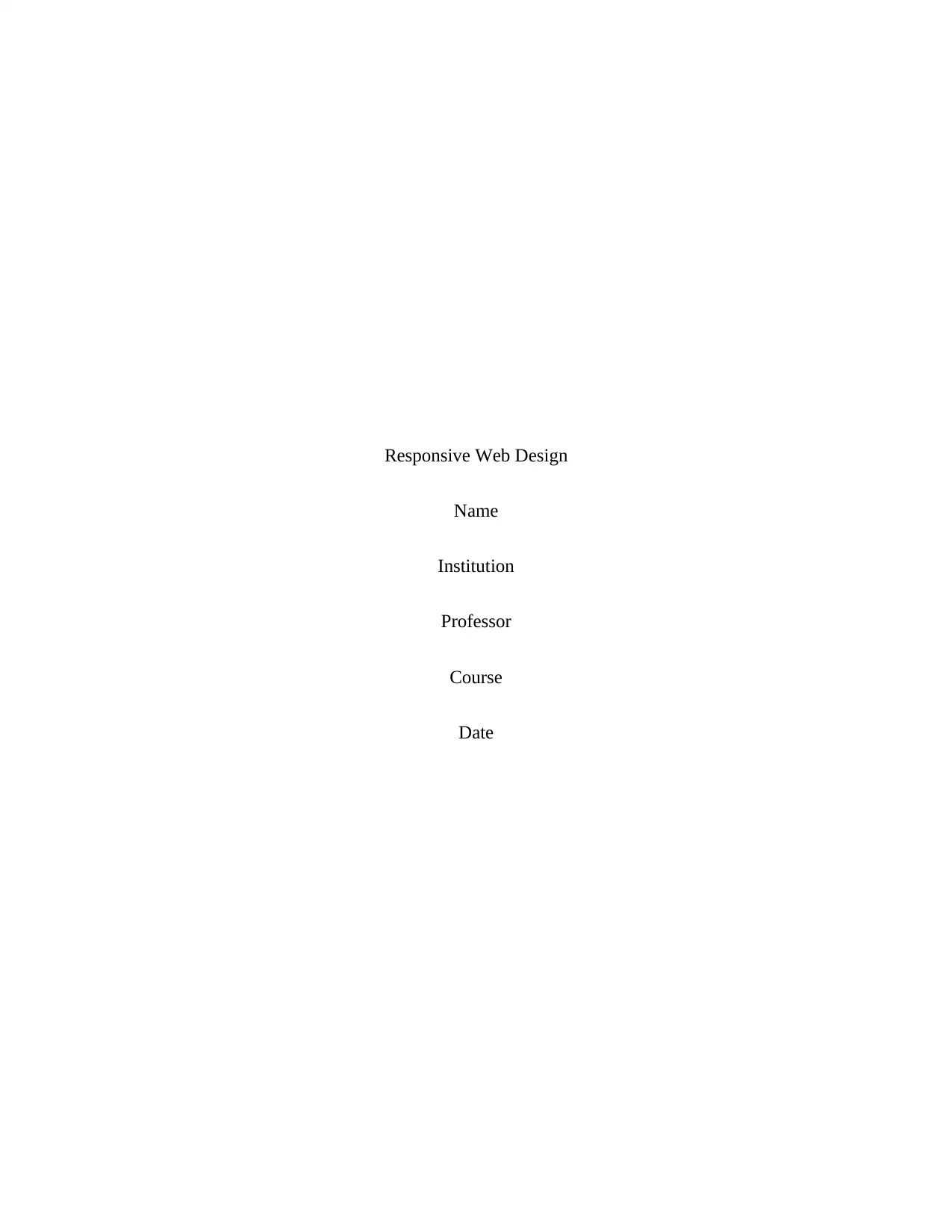
Responsive Web Design
Name
Institution
Professor
Course
Date
Name
Institution
Professor
Course
Date
Paraphrase This Document
Need a fresh take? Get an instant paraphrase of this document with our AI Paraphraser
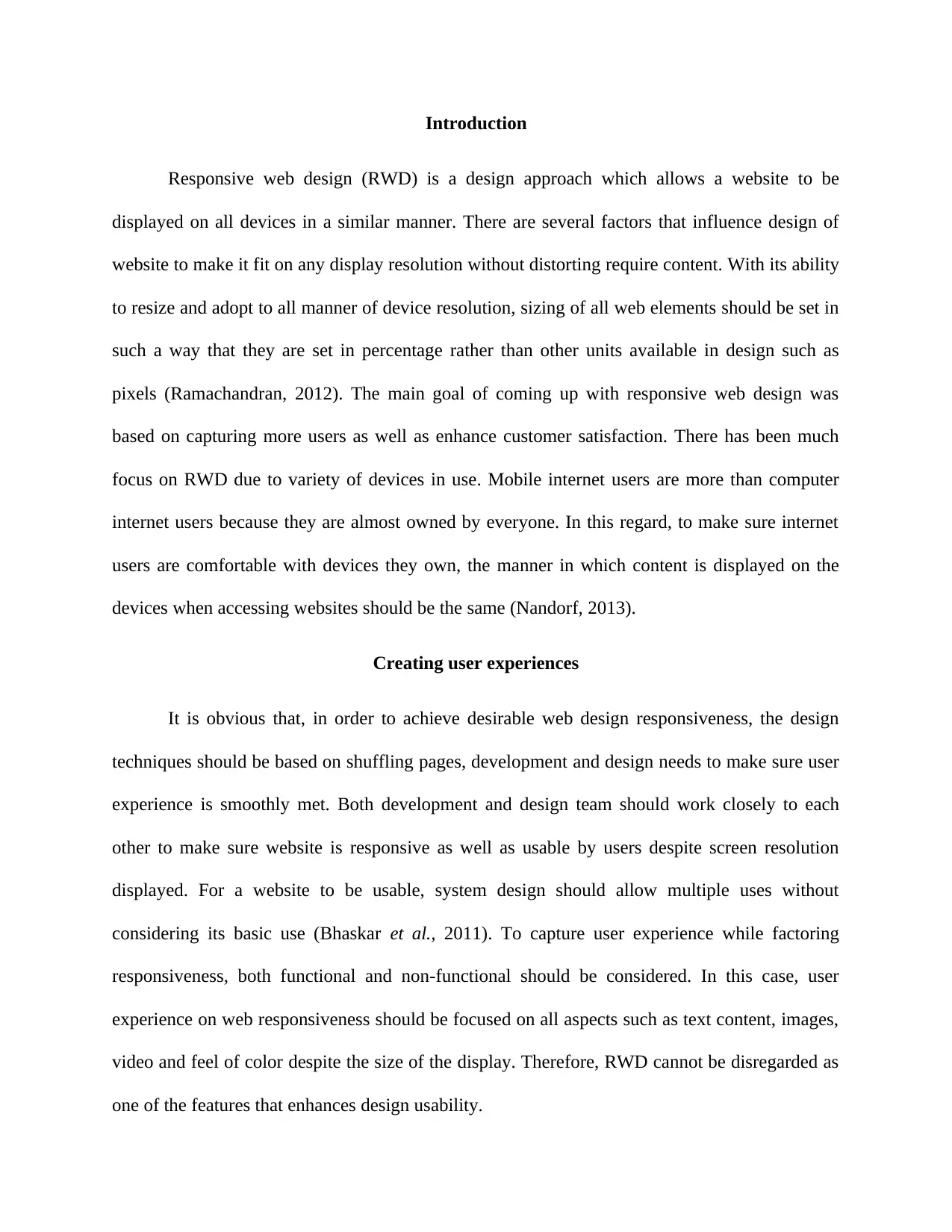
Introduction
Responsive web design (RWD) is a design approach which allows a website to be
displayed on all devices in a similar manner. There are several factors that influence design of
website to make it fit on any display resolution without distorting require content. With its ability
to resize and adopt to all manner of device resolution, sizing of all web elements should be set in
such a way that they are set in percentage rather than other units available in design such as
pixels (Ramachandran, 2012). The main goal of coming up with responsive web design was
based on capturing more users as well as enhance customer satisfaction. There has been much
focus on RWD due to variety of devices in use. Mobile internet users are more than computer
internet users because they are almost owned by everyone. In this regard, to make sure internet
users are comfortable with devices they own, the manner in which content is displayed on the
devices when accessing websites should be the same (Nandorf, 2013).
Creating user experiences
It is obvious that, in order to achieve desirable web design responsiveness, the design
techniques should be based on shuffling pages, development and design needs to make sure user
experience is smoothly met. Both development and design team should work closely to each
other to make sure website is responsive as well as usable by users despite screen resolution
displayed. For a website to be usable, system design should allow multiple uses without
considering its basic use (Bhaskar et al., 2011). To capture user experience while factoring
responsiveness, both functional and non-functional should be considered. In this case, user
experience on web responsiveness should be focused on all aspects such as text content, images,
video and feel of color despite the size of the display. Therefore, RWD cannot be disregarded as
one of the features that enhances design usability.
Responsive web design (RWD) is a design approach which allows a website to be
displayed on all devices in a similar manner. There are several factors that influence design of
website to make it fit on any display resolution without distorting require content. With its ability
to resize and adopt to all manner of device resolution, sizing of all web elements should be set in
such a way that they are set in percentage rather than other units available in design such as
pixels (Ramachandran, 2012). The main goal of coming up with responsive web design was
based on capturing more users as well as enhance customer satisfaction. There has been much
focus on RWD due to variety of devices in use. Mobile internet users are more than computer
internet users because they are almost owned by everyone. In this regard, to make sure internet
users are comfortable with devices they own, the manner in which content is displayed on the
devices when accessing websites should be the same (Nandorf, 2013).
Creating user experiences
It is obvious that, in order to achieve desirable web design responsiveness, the design
techniques should be based on shuffling pages, development and design needs to make sure user
experience is smoothly met. Both development and design team should work closely to each
other to make sure website is responsive as well as usable by users despite screen resolution
displayed. For a website to be usable, system design should allow multiple uses without
considering its basic use (Bhaskar et al., 2011). To capture user experience while factoring
responsiveness, both functional and non-functional should be considered. In this case, user
experience on web responsiveness should be focused on all aspects such as text content, images,
video and feel of color despite the size of the display. Therefore, RWD cannot be disregarded as
one of the features that enhances design usability.
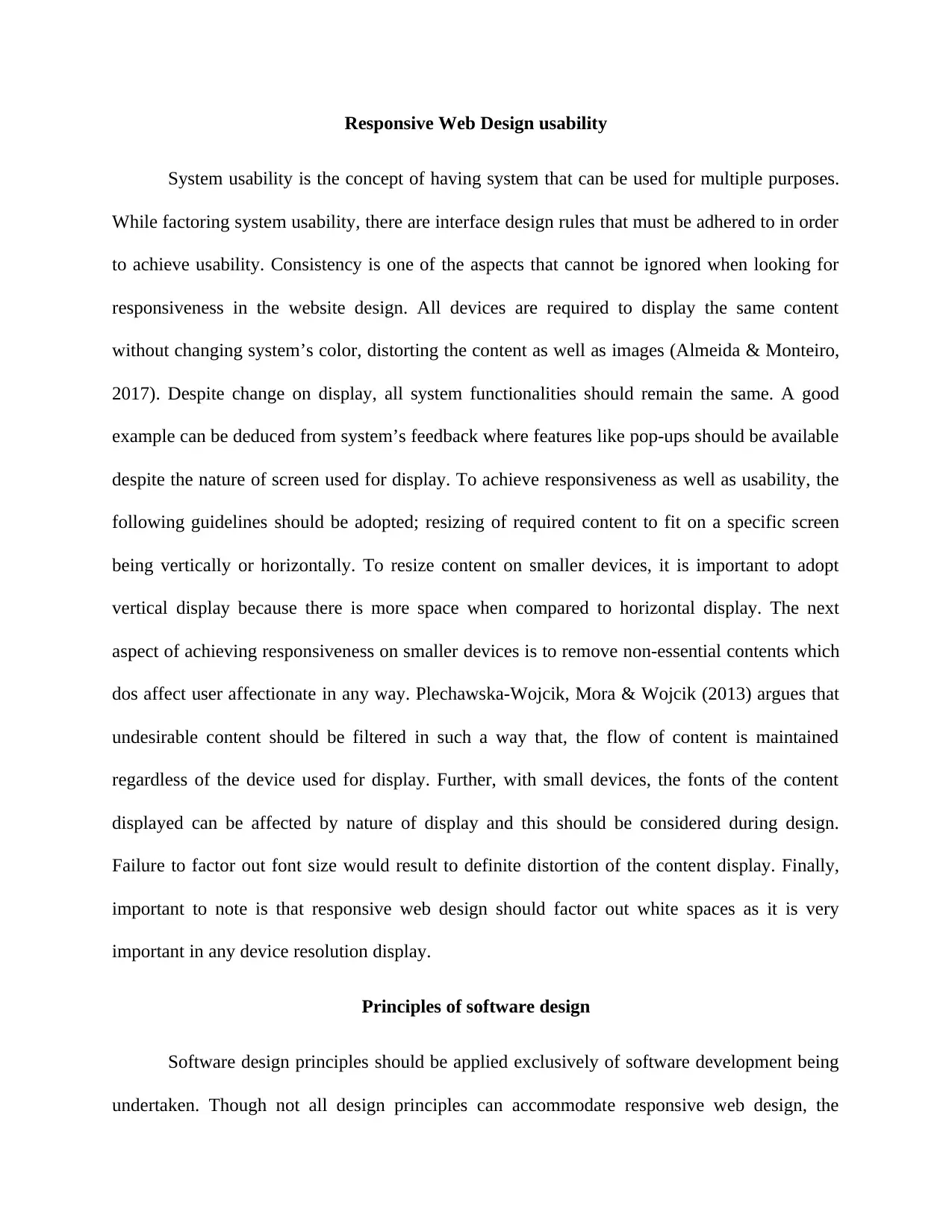
Responsive Web Design usability
System usability is the concept of having system that can be used for multiple purposes.
While factoring system usability, there are interface design rules that must be adhered to in order
to achieve usability. Consistency is one of the aspects that cannot be ignored when looking for
responsiveness in the website design. All devices are required to display the same content
without changing system’s color, distorting the content as well as images (Almeida & Monteiro,
2017). Despite change on display, all system functionalities should remain the same. A good
example can be deduced from system’s feedback where features like pop-ups should be available
despite the nature of screen used for display. To achieve responsiveness as well as usability, the
following guidelines should be adopted; resizing of required content to fit on a specific screen
being vertically or horizontally. To resize content on smaller devices, it is important to adopt
vertical display because there is more space when compared to horizontal display. The next
aspect of achieving responsiveness on smaller devices is to remove non-essential contents which
dos affect user affectionate in any way. Plechawska-Wojcik, Mora & Wojcik (2013) argues that
undesirable content should be filtered in such a way that, the flow of content is maintained
regardless of the device used for display. Further, with small devices, the fonts of the content
displayed can be affected by nature of display and this should be considered during design.
Failure to factor out font size would result to definite distortion of the content display. Finally,
important to note is that responsive web design should factor out white spaces as it is very
important in any device resolution display.
Principles of software design
Software design principles should be applied exclusively of software development being
undertaken. Though not all design principles can accommodate responsive web design, the
System usability is the concept of having system that can be used for multiple purposes.
While factoring system usability, there are interface design rules that must be adhered to in order
to achieve usability. Consistency is one of the aspects that cannot be ignored when looking for
responsiveness in the website design. All devices are required to display the same content
without changing system’s color, distorting the content as well as images (Almeida & Monteiro,
2017). Despite change on display, all system functionalities should remain the same. A good
example can be deduced from system’s feedback where features like pop-ups should be available
despite the nature of screen used for display. To achieve responsiveness as well as usability, the
following guidelines should be adopted; resizing of required content to fit on a specific screen
being vertically or horizontally. To resize content on smaller devices, it is important to adopt
vertical display because there is more space when compared to horizontal display. The next
aspect of achieving responsiveness on smaller devices is to remove non-essential contents which
dos affect user affectionate in any way. Plechawska-Wojcik, Mora & Wojcik (2013) argues that
undesirable content should be filtered in such a way that, the flow of content is maintained
regardless of the device used for display. Further, with small devices, the fonts of the content
displayed can be affected by nature of display and this should be considered during design.
Failure to factor out font size would result to definite distortion of the content display. Finally,
important to note is that responsive web design should factor out white spaces as it is very
important in any device resolution display.
Principles of software design
Software design principles should be applied exclusively of software development being
undertaken. Though not all design principles can accommodate responsive web design, the
⊘ This is a preview!⊘
Do you want full access?
Subscribe today to unlock all pages.

Trusted by 1+ million students worldwide
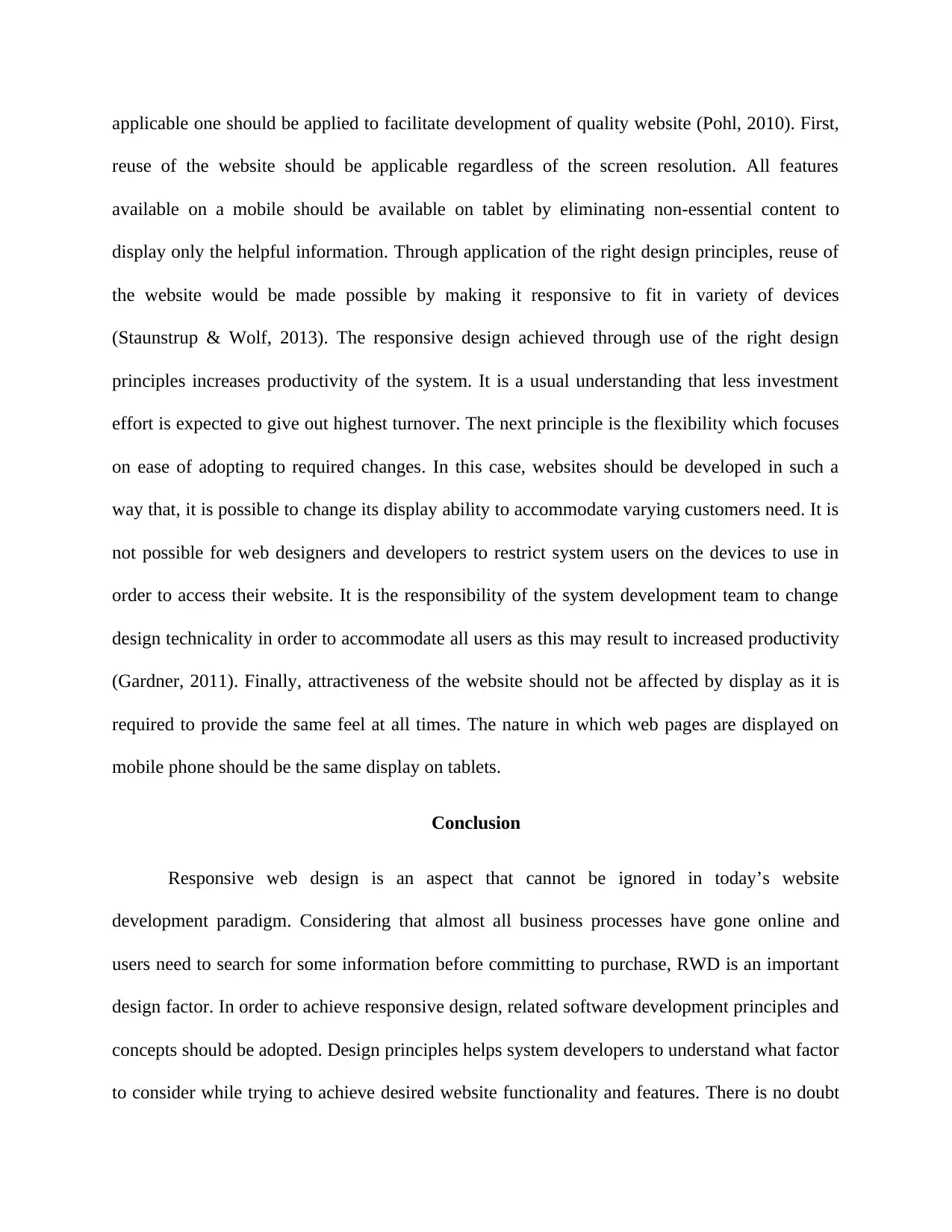
applicable one should be applied to facilitate development of quality website (Pohl, 2010). First,
reuse of the website should be applicable regardless of the screen resolution. All features
available on a mobile should be available on tablet by eliminating non-essential content to
display only the helpful information. Through application of the right design principles, reuse of
the website would be made possible by making it responsive to fit in variety of devices
(Staunstrup & Wolf, 2013). The responsive design achieved through use of the right design
principles increases productivity of the system. It is a usual understanding that less investment
effort is expected to give out highest turnover. The next principle is the flexibility which focuses
on ease of adopting to required changes. In this case, websites should be developed in such a
way that, it is possible to change its display ability to accommodate varying customers need. It is
not possible for web designers and developers to restrict system users on the devices to use in
order to access their website. It is the responsibility of the system development team to change
design technicality in order to accommodate all users as this may result to increased productivity
(Gardner, 2011). Finally, attractiveness of the website should not be affected by display as it is
required to provide the same feel at all times. The nature in which web pages are displayed on
mobile phone should be the same display on tablets.
Conclusion
Responsive web design is an aspect that cannot be ignored in today’s website
development paradigm. Considering that almost all business processes have gone online and
users need to search for some information before committing to purchase, RWD is an important
design factor. In order to achieve responsive design, related software development principles and
concepts should be adopted. Design principles helps system developers to understand what factor
to consider while trying to achieve desired website functionality and features. There is no doubt
reuse of the website should be applicable regardless of the screen resolution. All features
available on a mobile should be available on tablet by eliminating non-essential content to
display only the helpful information. Through application of the right design principles, reuse of
the website would be made possible by making it responsive to fit in variety of devices
(Staunstrup & Wolf, 2013). The responsive design achieved through use of the right design
principles increases productivity of the system. It is a usual understanding that less investment
effort is expected to give out highest turnover. The next principle is the flexibility which focuses
on ease of adopting to required changes. In this case, websites should be developed in such a
way that, it is possible to change its display ability to accommodate varying customers need. It is
not possible for web designers and developers to restrict system users on the devices to use in
order to access their website. It is the responsibility of the system development team to change
design technicality in order to accommodate all users as this may result to increased productivity
(Gardner, 2011). Finally, attractiveness of the website should not be affected by display as it is
required to provide the same feel at all times. The nature in which web pages are displayed on
mobile phone should be the same display on tablets.
Conclusion
Responsive web design is an aspect that cannot be ignored in today’s website
development paradigm. Considering that almost all business processes have gone online and
users need to search for some information before committing to purchase, RWD is an important
design factor. In order to achieve responsive design, related software development principles and
concepts should be adopted. Design principles helps system developers to understand what factor
to consider while trying to achieve desired website functionality and features. There is no doubt
Paraphrase This Document
Need a fresh take? Get an instant paraphrase of this document with our AI Paraphraser
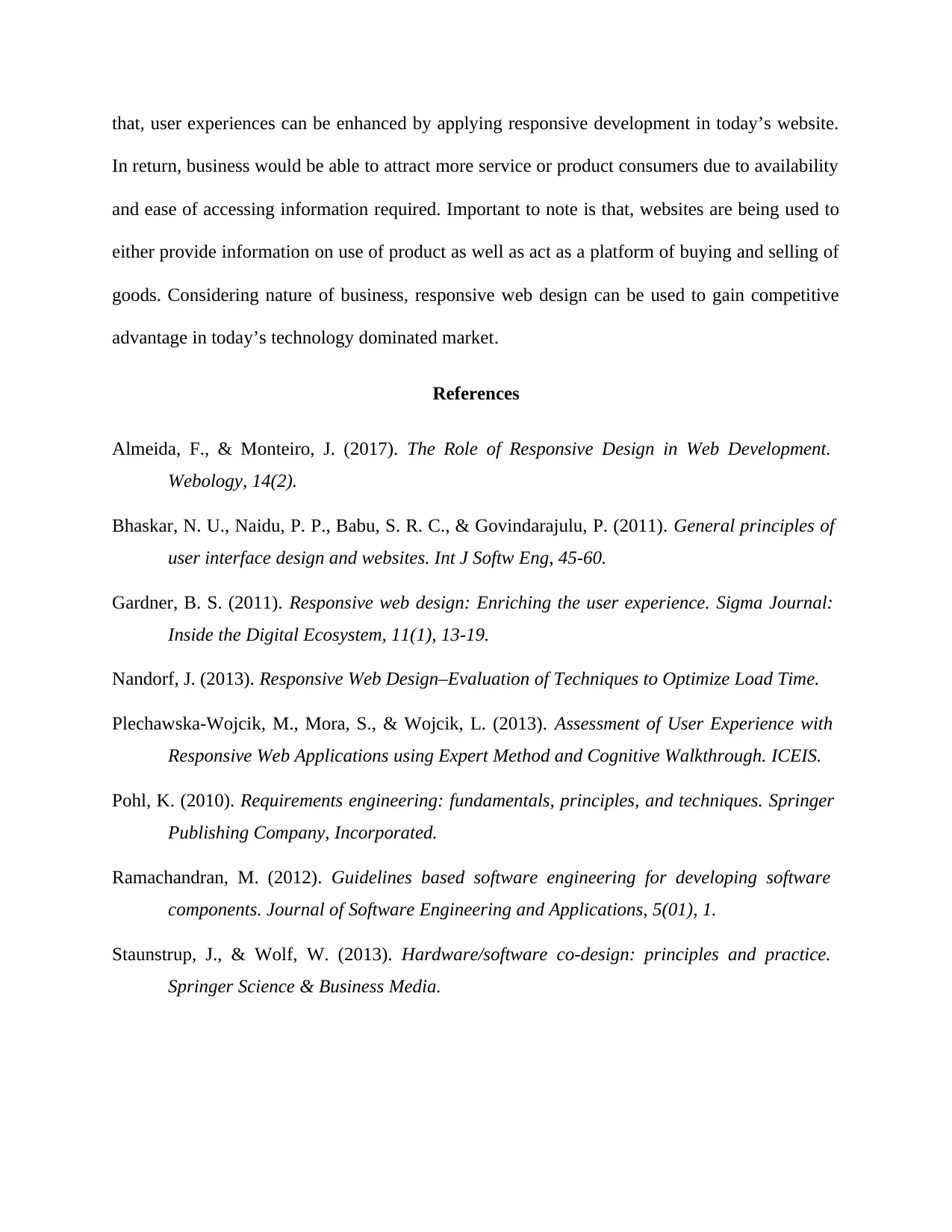
that, user experiences can be enhanced by applying responsive development in today’s website.
In return, business would be able to attract more service or product consumers due to availability
and ease of accessing information required. Important to note is that, websites are being used to
either provide information on use of product as well as act as a platform of buying and selling of
goods. Considering nature of business, responsive web design can be used to gain competitive
advantage in today’s technology dominated market.
References
Almeida, F., & Monteiro, J. (2017). The Role of Responsive Design in Web Development.
Webology, 14(2).
Bhaskar, N. U., Naidu, P. P., Babu, S. R. C., & Govindarajulu, P. (2011). General principles of
user interface design and websites. Int J Softw Eng, 45-60.
Gardner, B. S. (2011). Responsive web design: Enriching the user experience. Sigma Journal:
Inside the Digital Ecosystem, 11(1), 13-19.
Nandorf, J. (2013). Responsive Web Design–Evaluation of Techniques to Optimize Load Time.
Plechawska-Wojcik, M., Mora, S., & Wojcik, L. (2013). Assessment of User Experience with
Responsive Web Applications using Expert Method and Cognitive Walkthrough. ICEIS.
Pohl, K. (2010). Requirements engineering: fundamentals, principles, and techniques. Springer
Publishing Company, Incorporated.
Ramachandran, M. (2012). Guidelines based software engineering for developing software
components. Journal of Software Engineering and Applications, 5(01), 1.
Staunstrup, J., & Wolf, W. (2013). Hardware/software co-design: principles and practice.
Springer Science & Business Media.
In return, business would be able to attract more service or product consumers due to availability
and ease of accessing information required. Important to note is that, websites are being used to
either provide information on use of product as well as act as a platform of buying and selling of
goods. Considering nature of business, responsive web design can be used to gain competitive
advantage in today’s technology dominated market.
References
Almeida, F., & Monteiro, J. (2017). The Role of Responsive Design in Web Development.
Webology, 14(2).
Bhaskar, N. U., Naidu, P. P., Babu, S. R. C., & Govindarajulu, P. (2011). General principles of
user interface design and websites. Int J Softw Eng, 45-60.
Gardner, B. S. (2011). Responsive web design: Enriching the user experience. Sigma Journal:
Inside the Digital Ecosystem, 11(1), 13-19.
Nandorf, J. (2013). Responsive Web Design–Evaluation of Techniques to Optimize Load Time.
Plechawska-Wojcik, M., Mora, S., & Wojcik, L. (2013). Assessment of User Experience with
Responsive Web Applications using Expert Method and Cognitive Walkthrough. ICEIS.
Pohl, K. (2010). Requirements engineering: fundamentals, principles, and techniques. Springer
Publishing Company, Incorporated.
Ramachandran, M. (2012). Guidelines based software engineering for developing software
components. Journal of Software Engineering and Applications, 5(01), 1.
Staunstrup, J., & Wolf, W. (2013). Hardware/software co-design: principles and practice.
Springer Science & Business Media.

⊘ This is a preview!⊘
Do you want full access?
Subscribe today to unlock all pages.

Trusted by 1+ million students worldwide
1 out of 6
Related Documents
Your All-in-One AI-Powered Toolkit for Academic Success.
+13062052269
info@desklib.com
Available 24*7 on WhatsApp / Email
![[object Object]](/_next/static/media/star-bottom.7253800d.svg)
Unlock your academic potential
Copyright © 2020–2025 A2Z Services. All Rights Reserved. Developed and managed by ZUCOL.





